Pear Varieties:
A New Global Focus
Growing pears in the NW has been “playing the long game”. The market has been stable with opportunity being elusive. Tree Connection is testing a number of new pear varieties. Stay tuned for more information.
In the meantime, please let us help with all the current pear offerings from the best nurseries in the west.
Work With Tree Connection
Tree Connection works with breeders globally to find new pear varieties that are easier on the grower, but also very attractive to consumers. We have also been focused on dwarfing root development in an effort to bring pear production numbers up to financially feasible levels.
Please feel free to give us a call to talk about how we can help you reach your pear goals as quickly as possible.
Pear Varieties
| Photo | Fruit Type | Variety | Details | Common Pollenizers |
|---|---|---|---|---|
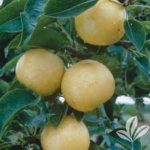 | Asian | 20th Century (Nijisseiki) | The medium-to-large fruit has a very smooth greenish-yellow skin and creamy white flesh that is juicy and aromatic. The tree is upright and productive. | Bartlett, Bosc, Chojuro, Shinseike |
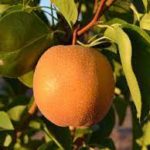 | Asian | Atago | Extra large, noticeably sweet and juicy fruit with a golden brown skin. Tree has moderately vigorous growth and is productive. Harvest is late season. This pear is a cross between Nijisseiki and Imamura Aki and is superior to Niitaka. Atago has a long and profuse bloom period, making it a good choice as a pollenizer. Very little thinning required for large fruit. Fruit hangs well on the tree. | |
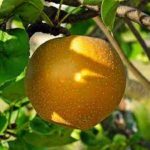 | Asian | Hosuei | An attractive fruit with a golden russeted skin. The flesh is firm, juicy and mild with good quality. Large to medium fruit with a crisp, juicy off-white flesh. Tree is large to medium-size, weeping with spreading growth. Productive with a late season harvest. Storage life is approx. 2 months. *May develop internal breakdown if stored too long when picked very ripe. | Shinko, Chojuro, Bartlett, 20th Century |
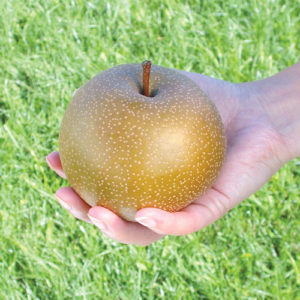 | Asian | Olympic | Very large and roundish fruit with firm flesh and a crisp, juicy, sweet taste. Skin is an attractive golden brown russet when ripe. Tree has very vigorous upright growth to a large size. Winter hardy and a late harvest. Storage life is 8 to 9 months. One of the best tasting pears and the preferred Korean Asian Pear. | |
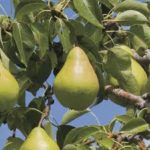 | European | Bartlett | Known as Williams outside of North America this large, golden yellow skin, brownish red blush, classic shape with smooth, white flesh. This “summer” pear is harvested from mid-August to mid-September and is very popular for both fresh eating and is the primary processed pear in the US. Bartlett bears young and the tree is productive, grows strong, and has a tendency for compact, upright growth. Pollenizes with Anjou, Bosc and Comice. | Anjou, Bosc, Comice |
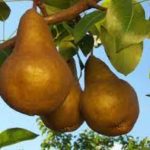 | European | Bosc - Golden Russet | It has been reported that this sport of Bosc, discovered in Oregon, has a more complete russet than traditional Bosc. The fruit on this vigorous tree type is long and uniform in shape. Flavor is similar to that of traditional Bosc, but harvests slightly earlier. | Anjou, Bosc, Comice |
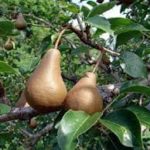 | European | Bosc - Bronze Beauty™ | This Bosc sport has a solid, heavy russet that completely encompasses the pear. When ripe, the russeting takes on a rich bronze color not typically found on other russeted pears. The fruit is medium to large with typical Bosc shape. When properly ripened at room temperature, the flesh is yellowish white, slightly granular, juicy and sweet. The tree is vigorous and large, exhibiting a spreading habit. | Anjou, Bosc, Comice |
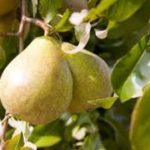 | European | Comice | Considered by many to produce the sweetest and juiciest of all pears. Their proper name is Doyenné du Comice pear tree first propagated near Angers in the mid 1800s. Comice pears are large, greenish-yellow when ripe. The flesh of Comice pears are buttery, sweet, tender and aromatic. Its low chilling requirement makes it suitable for low winter chill locations. As with Anjou pears, Comice pears need a period of cold storage before ripening. Shows good resistance fireblight. | Anjou, Bartlett, Bosc, Seckel |
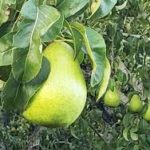 | European | d’Anjou | The 'Green Anjou' pear has a pale green skin that does not change color as the pear ripens. The d'Anjou is considered a medium to large pear, typically around 270–285 grams, 85 mm in height, and 80 mm in diameter. It has a wide, globular base, short stem, and thin skin. | Bartlett, Bosc, Comice, Seckel |
 | European | d’Anjou Columbia Red | This Anjou mutation was discovered in an orchard near Hood River, Oregon. It produces uniform oblong-ovate fruit that is red with golden-white flesh that has a smooth texture. The fruit matures in late August to mid-September and stores well. It is a vigorous tree that requires cross-pollination. Bartlett, Bosc, Comice, Seckel are pollen partners. | Bartlett, Bosc, Comice, Seckel |
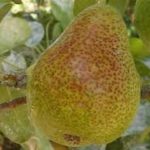 | European | Forelle | Produces a singularly handsome and distinctive fruit, yellow with a crimson blush and trout-like speckling (lenticels) from which comes the name Forelle, the German name for trout. The fruit is buttery without all the juice. And it has a faint but discernible cinnamon spiciness. The Forelle pears flesh is melting, aromatic and rich flavor. The tree is very productive. | Ya Li |
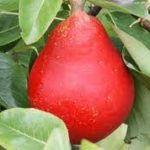 | European | Red Clapp (Super Red) | An early maturing, fresh market variety ripening ten days before Bartlett. Red Clapp’s is a mutation of the original Clapp’s Favorite. The fruit finishes with an attractive red color, is medium to large, with fine white flesh and good quality. The tree is vigorous, productive, and is sensitive to fireblight. | |
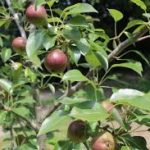 | European | Seckle | The Seckel Pear tree bears small dessert pears and is resistant to fireblight. Also called a “sugar pear” or “candy pear”, this fruit is sweet with a little spice. It is resistant to fireblight. It does not cross pollinate with Bartlett. | Bosc, Comice, Bartlett |
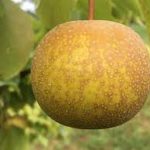 | Asian | Shinko | Large to medium fruit with excellent quality, yellow-white flesh, and a sweet juicy flavor. Skin is brown to golden-brown russet. Tree is moderately vigorous to a medium size. A heavy bearer that shows some fireblight resistance. Storage life is 3 to 4 months. | |
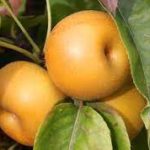 | Asian | Shinsui | Medium-size fruit with crisp off-white flesh. Very juicy and very sweet. Green-brown to orange-brown russet skin. Very vigorous tree with upright, erect growth. Early harvest. Storage life is approx. 6 weeks. Very good to excellent quality for an early season fruit. | |
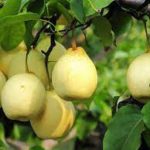 | Asian | Ya Li | Large to medium fruit with white flesh and a sweet fragrant flavor and aroma. Green to light green skin. Vigorous, upright spreading tree growth. Productive. Storage life is approx. 6 months. A smooth and glossy Chinese pear. | |
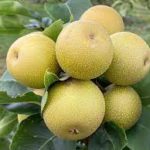 | Asian | Yoinashi™ | Large fruit with crisp off-white flesh, sweet and juicy, excellent quality. Skin is a buff-colored russet. Moderate to vigorous tree growth. Very productive. Storage life is approx. 3 to 4 months. | |
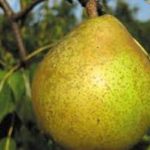 | Asian | Shin Li (USPP #6076) | Very large to large fruit with a full-bodied pear shape (pyriform). Firm, white crisp juicy flesh and a sweet, yet tart flavor. The skin is light to yellowish-green with large lenticels. Tree is medium to large size, upright, with slightly spreading growth. Storage life is 5 to 6 months. | |
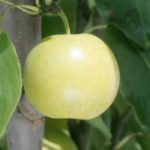 | Asian | Shinseki (New Century) | This yellow-skinned pear is medium in size with a smooth texture, creamy white flesh, and a mild, sweet taste. Tree is precocious, moderately vigorous with dense growth. Very productive. Storage life of fruit is 7 to 8 months. | Chojuro |
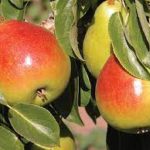 | European | Gem | A recently developed variety with good fireblight resistance and great storage ability, Gem grows on a tree that is productive and precocious. The variety has demonstrated fireblight resistance that is improved over that of Bartlett, but it is moderately susceptible to powdery mildew, scab, and psylla. Thinning improves fruit size significantly, and the fruit can be harvested over a long period. This pear is a recent product of breeding by Dr. Richard Bell, and while it has not yet been fully researched and evaluated, early trials have shown promise for both commercial production and the home grower. The fruit is mid-sized to large, slightly globular, and the skin is light green turning yellow when ripe with a red blush covering up to 35% of the fruit. It has a smooth, waxy surface and it does not develop superficial scald in storage. Gem pears have a long storage window. In dry growing conditions, it does not have russet issues. Bloom timing is about a day before Bartlett and harvests about a week later than Bartlett. This high yielding pear has a large harvest window. | Bartlett |
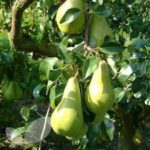 | European | Concorde | Concorde pears are small to medium in size with a large, round base that tapers into a long narrow, and pointed neck. The smooth skin is green-yellow with patches of red blushing and a golden-brown russeting connecting to a brown stem. The white to ivory flesh is dense, firm, and moist. When ripe, Concorde pears may still have a somewhat firm consistency and are aromatic, juicy, and sweet with floral notes and hints of vanilla. | Partially self-fruitful, but does better with a pollen partner. Bartlett, Shinseiki, Shinsui, Yoinashi |
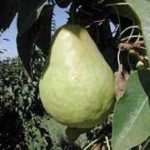 | European | Paragon | This OSU variety is a cross between Comice and Red Bartlett. Juicy, sweet and buttery flesh with a light skin. | |
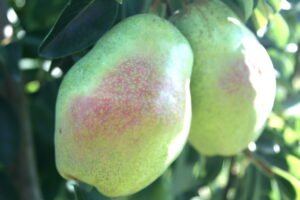 | European | Cold Snap® | A cold-hardy, fireblight-resistant pear from Canada. Also known as Cold Snap, Harovin Sundown. A vigorous, conical, upright-spreading tree, Cold Snap® is fireblight resistant and well suited to high-density planting. This pear is reliably annual and is pollen compatible with most other European pears; trials show poor pollination when paired with Bartlett. Ripening three weeks after Bartlett, the fruit is large and roundish, with an attractive blush. At harvest, the flesh is firm, with a pleasing, snappy crunch. At full ripeness, the pear is buttery and juicy. Tasters describe a floral flavor with notes of lemon. Cold Snap® is best eaten after about eight weeks in cold storage. It will store well for up to six months. Cold Snap® was originally bred as Harovin Sundown in the 1970's by H. A. Quamme. This variety was acquired by the Vineland Innovation and Research Center, which began selling trees in 2015. |


